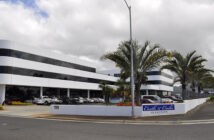Gone are the days of a security officer just sitting and watching a few security monitors. In today’s modern world of CCTV, analytical technologies have made it possible for humans to become superhumans.
Traditional security command centres included multiple closed circuit television (CCTV) monitors that provided centralised surveillance technology, giving security operators the ability to expand their limited physical area-of-coverage. Thus, instead of patrolling a select location, a security operator can now split their attention to multiple locations, panning back and forth from different areas-of-interest from the comfort of a chair. They can use their keen eye on a wider scale, but at the cost of a more fragmented approach. Active surveillance works better when there’s little activity, but a crowded venue or CCTV monitor creates natural blindness, we are only capturing snapshots in time of the activity. We are only human. Analytical technologies have made it possible to become superhuman.
The linear experience made it somewhat less complex and so, all we needed to do was sit back and watch. As an entertainment venue, television delivered information, but there was no interaction. The television changed society by informing the world what was going on around them and world-wide. Just as society became smarter with the information provided by television, security personal became smarter with CCTV.
Monitoring and security professionals are trained to be alert, observant and smart because monitoring security cameras is not linear, but the beginning of our new interactive media world. When a security professional observed or was radioed suspicious activity, they would need to evaluate and respond immediately, based on their experience and training and internal security policies and procedures for risk assessment, criticality and effectiveness.
However, there was always an inherent inefficiency in ‘human eye’ surveillance of multiple monitors presenting linear video, because of human nature. We can be easily distracted because we are not wired to absorb every single detail from a linear video presented to us, and studies show that the effectiveness of an operator monitoring two security cameras drops 95 percent in about 22 plus minutes. This is due to a number of issues from environmental ergonomics to behavioural; being bombarded by information overload.
Many of the command and control centers I’ve seen (from homeland security to schools, to major corporations and transportation hubs), include multiple video walls, multiple workstations with multiple monitors, multiple televisions playing 24 hour news (still informing us), all running a plethora of applications from video management system software, to incident reporting, 911 Emergency, intrusion detection, fire alarms, elevator alarms, access control, perimeter intrusion, and panic/duress alarms.
The world has changed dramatically since the invention of CCTV, which is nothing more than a linear collection of silent moving images. Security operators cannot absorb the necessary information fast enough because everything moves faster and there are too many monitors and not enough trained eyeballs to decipher their meaning. Monitoring operators typically work in four to eight hour shifts, and with hundreds of cameras, an active approach to surveillance becomes cumbersome and costly, and still plagued by the basic fact that human beings will have a difficult time monitoring live video feeds for extended periods of time.
Dr Richard Mayer, a psychology professor at the University of California, has done extensive research concerning cognition, instruction, and technology in multimedia learning, and thus proposed a ‘cognitive theory of multimedia learning’. He wanted to replace the behavioral perspective (what classrooms have been like most of the last century) on multimedia instruction with a more cognitive and constructivist approach. The behavioral perspective sees students as passively absorbing new knowledge, using practice activities, and memorisation, while a cognitive and constructivist approach in more ‘like real life experiences’ or ‘interactive’.
When an animation about how a bicycle tire pump works was presented concurrently with systematic narration, the students significantly outperformed those who just read a textbook. Additionally, using spatial contiguity (printed text, with related pictures near or integrated) students showed significantly better recall and problem solving skills (faster), than those that just read a textbook. When reading a book, or watching silent video imagery, you’re using a single channel of data consumption. When seeing imagery, listening to narration, and reading words together, as in a graphical user interface, you’ve opened up three channels of data consumption. Theoretically, you can absorb the information three times faster, or in the case of a security operator, you can make a decision three times faster. READ MORE






